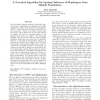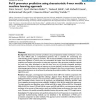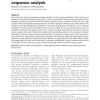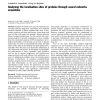621 search results - page 95 / 125 » DNA Computing |
CIBCB
2005
IEEE
13 years 9 months ago
2005
IEEE
— We present an integrative method for clustering coregulated genes and elucidating their underlying regulatory mechanisms. We use multi-state partition functions and thermodynam...
ISMB
2000
13 years 9 months ago
2000
The next phase of human genomics will involve largescale screens of populations for signi cant DNA polymorphisms, notably single nucleotide polymorphisms SNP's. Dense human S...
BMCBI
2008
13 years 7 months ago
2008
Background: Eukaryotic promoter prediction using computational analysis techniques is one of the most difficult jobs in computational genomics that is essential for constructing a...
BIB
2006
13 years 7 months ago
2006
One of the major goals of computational sequence analysis is to find sequence similarities, which could serve as evidence of structural and functional conservation, as well as of ...
NCA
2006
IEEE
13 years 7 months ago
2006
IEEE
Scientists involved in the area of proteomics are currently seeking integrated, customised and validated research solutions to better expedite their work in proteomics analyses and...




